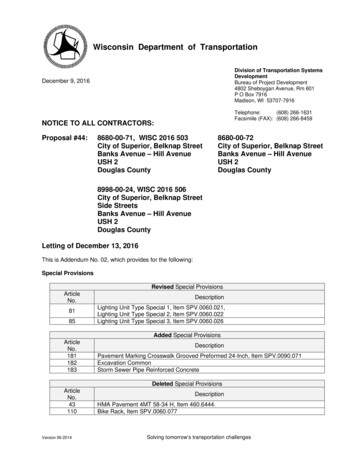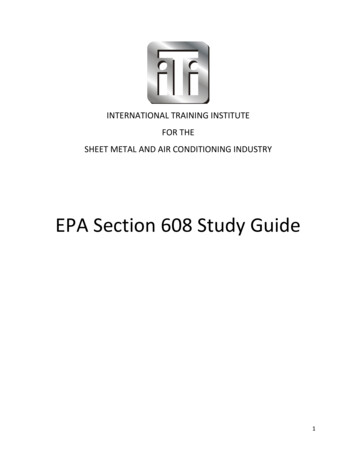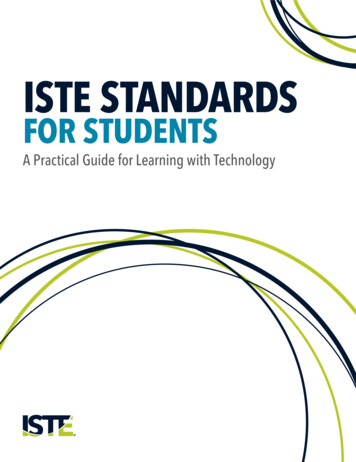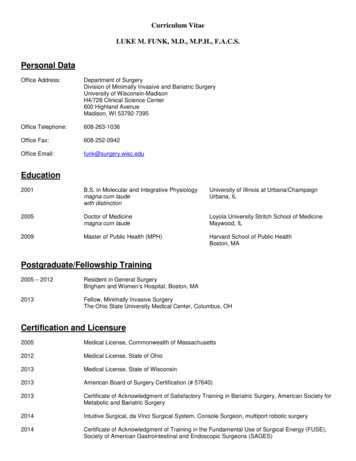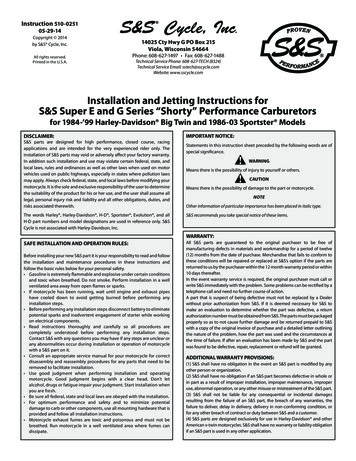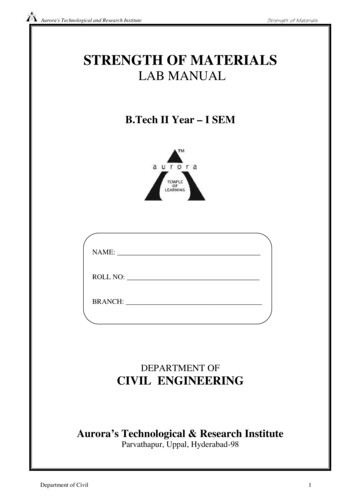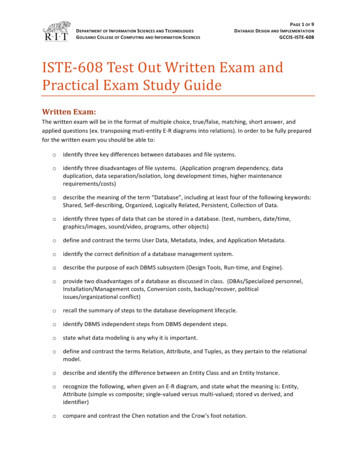
Transcription
D EPARTMENT OF I NFORMATION S CIENCES AND T ECHNOLOGIESG OLISANO C OLLEGE OF C OMPUTING AND I NFORMATION S CIENCESP AGE 1 OF 9D ATABASE D ESIGN AND I MPLEMENTATIONGCCIS-ISTE-608ISTE-608 Test Out Written Exam andPractical Exam Study GuideWritten Exam:The written exam will be in the format of multiple choice, true/false, matching, short answer, andapplied questions (ex. transposing muti-entity E-R diagrams into relations). In order to be fully preparedfor the written exam you should be able to:oidentify three key differences between databases and file systems.oidentify three disadvantages of file systems. (Application program dependency, dataduplication, data separation/isolation, long development times, higher maintenancerequirements/costs)odescribe the meaning of the term “Database”, including at least four of the following keywords:Shared, Self-describing, Organized, Logically Related, Persistent, Collection of Data.oidentify three types of data that can be stored in a database. (text, numbers, date/time,graphics/images, sound/video, programs, other objects)odefine and contrast the terms User Data, Metadata, Index, and Application Metadata.oidentify the correct definition of a database management system.odescribe the purpose of each DBMS subsystem (Design Tools, Run-time, and Engine).oprovide two disadvantages of a database as discussed in class. (DBAs/Specialized personnel,Installation/Management costs, Conversion costs, backup/recover, politicalissues/organizational conflict)orecall the summary of steps to the database development lifecycle.oidentify DBMS independent steps from DBMS dependent steps.ostate what data modeling is any why it is important.odefine and contrast the terms Relation, Attribute, and Tuples, as they pertain to the relationalmodel.odescribe and identify the difference between an Entity Class and an Entity Instance.orecognize the following, when given an E-R diagram, and state what the meaning is: Entity,Attribute (simple vs composite; single-valued versus multi-valued; stored vs derived, andidentifier)ocompare and contrast the Chen notation and the Crow’s foot notation.
D EPARTMENT OF I NFORMATION S CIENCES AND T ECHNOLOGIESG OLISANO C OLLEGE OF C OMPUTING AND I NFORMATION S CIENCESP AGE 2 OF 9D ATABASE D ESIGN AND I MPLEMENTATIONGCCIS-ISTE-608odescribe what an identifier is and its usage.oappropriately represent simple identifiers and composite identifiers, using either Chen or Crow’sfeet notation.odescribe a composite identifier.olist the steps involved in creating a database.otranspose an E-R diagram, with Chen or Crow’s Feet notation, of a single entity into a relation.odescribe what a relation is and what rows and columns of a relation represent.odescribe at least five characteristics of a relation.odetermine whether or not a given relation conforms to all of the characteristics of a relation.odescribe a primary key in terms of its purpose and characteristics.olist the steps involved in creating a database.olist and describe the two types of SQL statements.oclassify SQL statements (CREATE, DROP, INSERT, and SELECT) as appropriate type of SQLstatement (DDL/DML).oknow the required clauses of a SELECT statement.odescribe what a NULL value is.oclassify SQL statements (ALTER, UPDATE, and DELETE) as appropriate type of SQL statement(DDL/DML).ostate that normalization is part of the representational level of the development process.odetermine functional dependencies between attributes for a given relation.ouse proper notation for functional dependencies.odescribe a candidate key.odescribe a primary key.odetermine what candidate keys exist when given a relation and a list of functionaldependencies.oselect an appropriate primary key based on any candidate keys present, when given a relationand a list of functional dependencies.odescribe what an anomaly is.oidentify the different types of anomalies: Insertion, Modification, and Deletion.
D EPARTMENT OF I NFORMATION S CIENCES AND T ECHNOLOGIESG OLISANO C OLLEGE OF C OMPUTING AND I NFORMATION S CIENCESP AGE 3 OF 9D ATABASE D ESIGN AND I MPLEMENTATIONGCCIS-ISTE-608oidentify the determinant when given a functional dependency.oidentify composite keys: primary and candidate.odescribe second normal form and its violation.oidentify any partial dependencies when given a relation and functional dependencies.ocorrectly fix second normal form violations, including correctly denoting a foreign key andcomposing a reference statement, when given a relation and functional dependencies.odescribe a foreign key.odescribe what referential integrity is and why it is important.odescribe third normal form and its violation.oidentify any transitive dependencies, when given a relation and functional dependencies.ocorrectly fix third normal form violations, including correctly denoting a foreign key andcomposing a reference statement, when given a relation and functional dependencies thatcause transitive dependencies.odescribe Boyce-Codd normal form and its violation.ocorrectly fix BCNF violations, including correctly denoting a foreign key and composing areference statement, when given a relation and functional dependencies that include adeterminant that is not a candidate key.omodify the original and all resulting relations through BCNF, including correct foreign keys andreference statements, when given a relation and functional dependencies.odescribe the correlation between the quality of a data model and impact on the normalizationprocess.odetermine the highest normal form that a relation is in when given a relation and a list offunctional dependencies.odescribe the connection between the quality of an E-R diagram and the implications on thenormalization process.odescribe the difference between a relationship class and a relationship instance.odetermine the degree of the relationship, when given an E-R diagram.odistinguish binary relationships from recursive relationships, when given an E-R diagram.ointerpret the maximum cardinalities for a relationship and provide the cardinality ratio, whengiven an E-R diagram.
D EPARTMENT OF I NFORMATION S CIENCES AND T ECHNOLOGIESG OLISANO C OLLEGE OF C OMPUTING AND I NFORMATION S CIENCESP AGE 4 OF 9D ATABASE D ESIGN AND I MPLEMENTATIONGCCIS-ISTE-608ointerpret the minimum cardinalities for a relationship to determine if an entity is required toparticipate in a relationship or not, when given an E-R diagram.ofully explain a relationship, using non-technical terms, that include the implications of theminimum and maximum cardinalities from both perspectives, when given an E-R diagram.ocompare and contrast “HAS-A” relationships to “IS-A” relationships.odescribe the difference between a supertype and a subtype.oidentify any supertypes and subtypes, when given an E-R diagram.odistinguish a strong entity from a weak entity, when given an E-R diagram.odetermine the two main reasons supertype/subtype relationships are necessary.odescribe the implications of having a relationship at the supertype-level versus the subtypelevel.odetermine whether the completeness constraint for the relationship is total or partialspecialization and the implications of both on the supertype/subtype relationship, when givenan E-R diagram.odetermine the disjointedness constraint and whether the overlap or disjoint rule is in effect andthe implications on the supertype/subtype relationship, when given an E-R diagram.odetermine an appropriate discriminator based on if the disjoint or overlap rule is in effect for asupertype/subtype relationship, when given an E-R diagram.odescribe, in non-technical terms, the full supertype/subtype relationship including completenessand disjointedness constraints, when given an E-R diagram.ocorrectly transpose the diagram into a set of relations in relational schema notation, when givenan E-R diagram that includes strong and weak entities, with binary, recursive, andsupertype/subtype relationships.odescribe foreign key placement for a 1:1, 1:N (N:1), M:N, or supertype/subtype relationship.oexplain the difference between the participation constraints (total participation and partialparticipation).odetermine whether the weak entity is ID-Dependent or Non-ID Dependent, when given an E-Rdiagram that includes a HAS-A relationship between a strong and a weak entity, along withfunctional dependencies.otranspose an E-R diagram with proper placement of the foreign key based on whether therelationships are identifying or not, when given an E-R diagram that distinguishes betweenidentifying and non-identifying relationships.
D EPARTMENT OF I NFORMATION S CIENCES AND T ECHNOLOGIESG OLISANO C OLLEGE OF C OMPUTING AND I NFORMATION S CIENCESP AGE 5 OF 9D ATABASE D ESIGN AND I MPLEMENTATIONGCCIS-ISTE-608ocorrectly interpret and transpose a M:N relationship with attributes of the relationship, whengiven an E-R diagram.ocorrectly interpret and transpose an associative entity, when given an E-R diagram.oexplain why a M:N relationship with attributes for the relationship is equivalent to two – 1:Nrelationships with an associative entity.otranspose the E-R diagram and normalize all relations through BCNF, when given an E-R diagramand functional dependencies.ostate benefits of lookup tables.odescribe what referential integrity is, why it is important, and how it is implemented in adatabase.ostate that a transaction is a logical unit of work.ostate that a transaction can be composed of one or more statements.oexplain the purpose of COMMIT.oclassify COMMIT as a Transaction Control Language (TCL) statement.oexplain the purpose of ROLLBACK.oclassify ROLLBACK as a Transaction Control Language (TCL) statement.olist the properties of a tranaction contained in the ACID acronym.odescribe the Atomicity property of a transaction.odescribe the Consistency property of a transaction.odescribe the Isolation property of a transaction.odescribe the Durability property of a transaction.ocompose a theoretical relational algebra statement that would satisfy a specified query, whengiven a set of relations. Operations include SELECTION, PROJECTION, UNION, DIFFERENCE,PRODUCT, INTERSECTION, and Joins (EQUIJOIN, NATURAL, LEFT OUTER, RIGHT OUTER, and FULLOUTER).oderive the resulting relation, when given a set of relations and a theoretical relational algebrastatement.ostate the conditions for union compatibility.odetermine if two relations are union compatible.ospecify the relational algebra operations that are commutative.
D EPARTMENT OF I NFORMATION S CIENCES AND T ECHNOLOGIESG OLISANO C OLLEGE OF C OMPUTING AND I NFORMATION S CIENCESP AGE 6 OF 9D ATABASE D ESIGN AND I MPLEMENTATIONGCCIS-ISTE-608odescribe the operations involved in performing a relational algebra join.odescribe how a relational algebra operation is accomplished in SQL.orecognize the difference in structure between a SQL 89 formatted join and a SQL 92 formattedjoin.odescribe the structure of a subquery, including how results are passed from a nested query tothe outer query.oexplain the difference between the WHERE clause and the HAVING clause of a SELECTstatement.ostate which clauses of an SELECT statement are required and which are optional.ostate the proper order for clauses in a SELECT statement, including FROM, GROUP BY, HAVING,SELECT, ORDER BY, and WHERE.odescribe the structure of a highly abstract table.ostate the advantages and disadvantages of highly abstract tables.Practical Exam:If you receive an 80% or higher on the written exam, you will be allowed to take the practical exam.The practical will involve the use of MySQL in order to accomplish tasks provided for you to complete.You will only have access to the MySQL help system during the practical exam. In order to be fullyprepared for the final practical, you should be able to accomplish the following through your knowledgeof MySQL and SQL:ocreate a database.oopen a database.owrite a CREATE TABLE statement with attributes of appropriate datatypes (CHAR, VARCHAR,INT, and DATE) and a constraint for the primary key.ocompose a DROP DATABASE statement.ocompose a DROP TABLE statement.oexecute commands to view metadata (SHOW DATABASES; SHOW TABLES; and DESCRIBE).ocreate a script containing one or more DDL or DML statement.oexecute a script.owrite a SELECT statement that will view all attributes and all records from a single table.owrite a SELECT statement that contains only a subset of available attributes.
D EPARTMENT OF I NFORMATION S CIENCES AND T ECHNOLOGIESG OLISANO C OLLEGE OF C OMPUTING AND I NFORMATION S CIENCESP AGE 7 OF 9D ATABASE D ESIGN AND I MPLEMENTATIONGCCIS-ISTE-608oapply a column alias in the SELECT clause of a SELECT statement.oform an appropriate WHERE clause, of a SELECT statement, that includes logical operators (NOT,AND, and OR).ofind records where a specified attribute has one or more NULL values.oinsert a record that has one or more NULL values.orecognize data that should be stored as SMALLINT and DECIMAL, when given an attributedescription.ouse SIGNED and UNSIGNED appropriately for integer data types, when given an attributedescription.oapply NOT NULL constraints appropriately in a CREATE TABLE statement, when given attributedescriptions.oset DEFAULT values appropriately in a CREATE TABLE statement, when given attributedescriptions.oappropriately use the following relational operators in SELECT statements, as needed: , , , , , , ! , IN, LIKE.oform an appropriate WHERE clause, of a SELECT statement, that includes logical operator,BETWEEN.oapply LIKE using wildcards (' ' and '%') to form a search pattern that meets specifications.operform basic calculations using an attribute in a SELECT statement.owrite a CREATE TABLE statement with attributes of appropriate datatypes (CHAR, VARCHAR,INT, and DATE), when given attribute specifications, and a constraint for the primary key.ocompose an UPDATE statement that will meet provided specifications.ocompose a DELETE statement that will meet provided specifications.oform an ALTER TABLE statement that meets specifications provided.oALTER TABLE to DROP ADD a PRIMARY KEY.oALTER TABLE to DROP ADD a column meeting provided specifications.oALTER TABLE to SET DROP a DEFAULT value specified.oALTER TABLE to MODIFY a COLUMN to meet provided specifications.owrite CREATE TABLE statements that will implement a provided schema (E-R diagram,transposed relations, and attribute specifications) with attributes of appropriate data types(CHAR, VARCHAR, INT (signed vs unsigned), SMALLINT (signed vs unsigned), TINYINT (signed vs
D EPARTMENT OF I NFORMATION S CIENCES AND T ECHNOLOGIESG OLISANO C OLLEGE OF C OMPUTING AND I NFORMATION S CIENCESP AGE 8 OF 9D ATABASE D ESIGN AND I MPLEMENTATIONGCCIS-ISTE-608unsigned), DECIMAL, BOOLEAN, DATE, and ENUM), and correct use of NOT NULL constraints.Each statement will also include a correct primary key constraint and necessary foreign keyconstraint(s).odetermine if a NOT NULL constraint is needed when implementing a specific foreign key, whengiven an E-R diagram and transposed relations.oorganize a series of CREATE TABLE and INSERT statements so that the execution order doesn’tcause any errors due to sequencing.odefine an attribute as AUTO INCREMENT, when appropriate.ocompose an INSERT statement that will result in AUTO INCREMENT being used to determine anattribute's value, when AUTO INCREMENT was used to define the respective attribute.oimplement appropriate discriminating attribute(s) in a CREATE TABLE statement, when given anE-R diagram that includes a supertype/subtype relationship.odetermine and implement an appropriate ON UPDATE condition for a foreign key constraint,when given an E-R diagram and transposed relations.odetermine and implement an appropriate ON DELETE condition for a foreign key constraint,when given an E-R diagram and transposed relations.oINSERT a record into a table that includes results from a SELECT statement, when given an E-Rdiagram and transposed relations.osuccessfully implement a transaction that is composed of more than one statement, given a listof tasks and MySQL.ocompose a correct ALTER TABLE statement that will add an appropriate foreign key constraint.ocompose a correct ALTER TABLE statement that will drop an existing foreign key constraint.ocompose the SQL equivalent statement to produce the resulting relation, when given arelational schema implemented in SQL and a theoretical relational algebra statement.Statement operations can include SELECTION, PROJECTION, UNION, DIFFERENCE, PRODUCT,INTERSECTION, and Joins (EQUIJOIN, NATURAL, LEFT OUTER, RIGHT OUTER, and FULL OUTER).oappropriately utilize DISTINCT when composing queries of relational algebra operations in SQL.owrite a CREATE TABLE statement that includes UNIQUE constraints for any candidate key(s) thatweren't selected as the primary key.owrite a SELECT statement that includes table aliases.ocompose a SELECT statement that property joins multiple tables together, using either SQL 89(inner join) or SQL 92 (inner and outer joins) format.
D EPARTMENT OF I NFORMATION S CIENCES AND T ECHNOLOGIESG OLISANO C OLLEGE OF C OMPUTING AND I NFORMATION S CIENCESP AGE 9 OF 9D ATABASE D ESIGN AND I MPLEMENTATIONGCCIS-ISTE-608ocompose a subquery (an outer query that includes one or more nested queries) that willaccomplish a task that requires data to be passed from one or more tables to another.owrite a SELECT statement that appropriately utilizes any of the following single-row, characterfunctions: LOWER(), UPPER(), LENGTH(), INSTR(), SUBSTR(), and CONCAT().owrite a SELECT statement that appropriately utilizes any of the following single-row, numericfunctions: ROUND(), TRUNCATE(), and MOD().owrite a SELECT statement that appropriately utilizes any of the following multi-row functions:COUNT(), AVG(), SUM(), MIN(), MAX().ocorrectly incorporate a GROUP BY clause, when using multi-row function(s) and also displayingother attributes as part of the SELECT clause of a SELECT statement.ocorrectly incorporate a HAVING clause within a SELECT statement, when needing to eliminaterecords from a result set based on the results of an aggregate function.ocorrectly incorporate an ORDER BY clause within a SELECT statement, when needing to sort aresult set by specified criteria.
Practical Exam Study Guide Written Exam: The written exam will be in the format of multiple choice, true/false, matching, short answer, and applied questions (ex. transposing muti-entity E-R diagrams into relations). In order to be f
